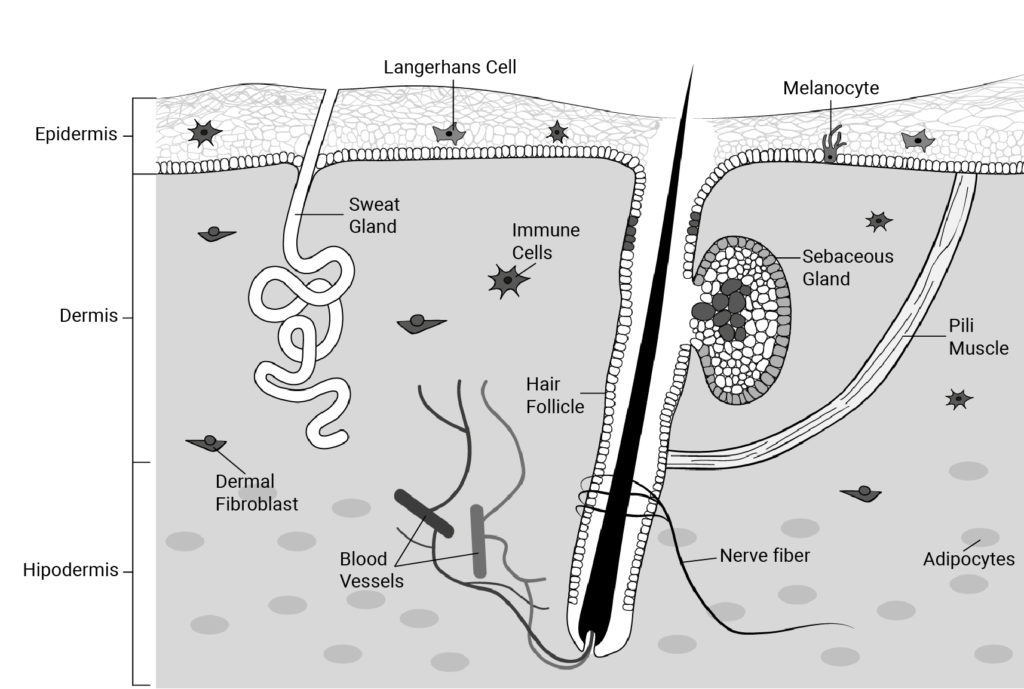Will your skin care for cannabidiol (CBD)?
Yes. Here is why.
Once upon a time, people thought of their skin as a passive “wall” that should be polished so that it will glow. Instead, think of it as a complex organ that contains neuronal networks, it is constantly self-remodeling itself, and modifying non-neuronal cells and mini-organs like the hair follicle and sebaceous glands. It is also a place where immunological machinery is involved in inflammation and immune defense. and a factory of growth factors, vasoactive chemicals, and hormones.
The skin is a “feeling machine”, and it has to be because it is the means by which we interact with our environment.

Figure: the skin is a complex system that receives signals from the rest of the body and sends signals that allow us to respond to changes in the environment. Illustration by Magda Levy.
The skin is one of the many organs that is equipped with the endocannabinoid system. You may have heard about anandamine. Discovered by Rapahel Mechoulam in 1992, this is one great detective story. If humans have receptors for cannabinoids, CB1, and CB2, there has to be a natural chemical that binds to those receptors. Mechoulam and his coworkers found and characterized that natural chemical, anandamide. 2-arachidonoylglycerol is another natural ligand.
It happens that the skin also has receptors for anandamide. There is not much we can do to increase our endogenous anandamide levels, although chocolate contains chemicals resembling anandamide and I have no doubt that chocolate helps. The good news is that cannabidiol (CBD) is now allowed in skincare products and CBD could help with some skin problems. Let me tell you why.
The cannabinoid signaling extends to the skin and is involved in the maintenance of skin homeostasis, barrier formation, and regeneration. Disruption of the cutaneous cannabinoid system may be involved in several skin diseases and disorders, like atopic dermatitis, psoriasis, scleroderma, acne, hair loss, pigmentation disorders, keratin diseases, and itch.
All of this research is relatively new so we should keep our eyes open for future confirmation (or reversals). In the meantime, let’s take with caution the assertion that anandamide may be linked to hypertrophic scars. I would concentrate on the most immediate effects of endogenous cannabinoids and say, with confidence, that they are involved in pain and itch.
Fortunately, we now are able to add cannabidiol topically and “top-up” our skin endogenous cannabinoids, for when we need them most. Example: when the skin hurts or itches. I personally, have ELS with CBD on my desk and bathroom and apply it to itchy scars and skin. From what I read, I expect some extra benefits, like faster healing and increased immune competence.
I wonder if that mystery of why we love to be in the sun even when we know that it’s bad for us has to do with endocannabinoids. In fact, UV affects every aspect of the skin which is a complex neuro-endocrine system that also communicates with the central nervous, endocrine, and immune systems.
Stay tuned, our cannabidiol (CBD) products, which I have been testing (and benefiting from) for a while, will be available for sale this month.
References
Bíró, T., Tóth, B. I., Haskó, G., Paus, R., & Pacher, P. (2009). The endocannabinoid system of the skin in health and disease: novel perspectives and therapeutic opportunities. Trends in Pharmacological Sciences, 30(8), 411–420. doi:10.1016/j.tips.2009.05.004
Di Tomaso, E., Beltramo, M., & Piomelli, D. (1996). Brain cannabinoids in chocolate. Nature, 382(6593), 677–678. doi:10.1038/382677a0
Tóth, K., Ádám, D., Bíró, T., Oláh, A., 2019. Cannabinoid Signaling in the Skin: Therapeutic Potential of the “C(ut)annabinoid” System. Molecules. doi:10.3390/molecules24050918
Maccarrone, M., Bab, I., Bíró, T., Cabral, G. A., Dey, S. K., Di Marzo, V., … Zimmer, A. (2015). Endocannabinoid signaling at the periphery: 50 years after THC. Trends in Pharmacological Sciences, 36(5), 277–296. doi:10.1016/j.tips.2015.02.008
